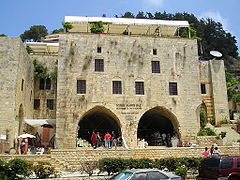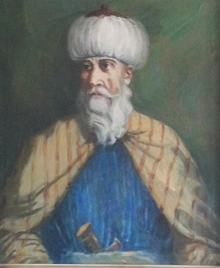Fachr ad-Dīn II.

Emir Fachr ad-Dīn II. ( Arabic فخر الدين بن معن, DMG Faḫr ad-Dīn b. Man orفخر الدين المعني الثاني, DMG Faḫr ad-Dīn al-Maʿnī aṯ-ṯānī , English Fakhr al-Din or French Fakhreddine ; born August 6, 1572 ; died April 13, 1635 ) was a Druze prince. He came from the Maʿan family and was ruler of the emirate of Chouf . He repeatedly strived for greater independence of his domain from the Ottomans and is therefore sometimes referred to as the "First Man of Lebanon".
origin
Fachr ad-Dīn was born in Baaklin . He was the son of Prince Qorqmaz ibn Maʿn (Korkmaz, Arabic الامير قرقماز بن معن= the fearless; died 1583) and Sit Nasab ( Arabic الست نسب) a lady of the Tanukhi family. He received the title “Emir” (Arabic prince) because his family played a prominent role in the area of the Chouf and beyond. He is often referred to as "Fachr ad-Dīn II." To distinguish him from his grandfather Fachr ad-Dīn I (d. 1544). Like other members of his family, he also held the title of Sandschakbey (governor / tax officer) of Sidon or Beirut . According to some sources, he spent the first years of his life in the village of Abey (عبيه). His father and grandfather had been executed by the Ottomans . His mother had him raised in Keserwan by the Christian- Maronite family Khazen , whose son, Abu Nadir, remained his friend and advisor until the end.
Career
In 1608 Fachr ad-Dīn concluded an alliance with the Italian Grand Duchy of Tuscany . It consisted of a public economic contract and a secret military agreement. During this time he expanded his fortresses and also built the palace in Dair al-Qamar .
Fachr ad-Dīn's ambitions, popularity and illicit diplomatic practices put the Ottomans on alert. Hafız Ahmed Pasha, the Muhafız of Damascus , was dispatched in 1613 to conduct a military operation in Lebanon and to restrict the power of Fachr ad-Dīn.
Faced with the superior army of Hafız with 50,000 men, Fachr ad-Dīn decided to go into exile in Tuscany . During this time he left the business of government to his brother and son, Emir Yunis and Emir Ali Bey . They were able to hold most of the fortresses ( e.g. Banias (Subayba) and Niha ). He had paid his standing army of Sekban (mercenaries) the wages for two years to buy their loyalty.
exile
Fachr ad-Dīn was welcomed as a guest by the Medici family in Tuscany . He was received by Duke Cosimo II and kept during the two years of his stay there. He spent three more years as a guest of the Duke of Osuna , the Spanish viceroy of Sicily and Naples . Fachr ad-Dīn campaigned for a crusade to free his homeland from Ottoman rule. However, his efforts did not bring the desired success. He had to realize that it was more important for the European powers to do business with the Ottomans. During his stay, however, he witnessed the Renaissance in Europe and transported some of the ideas and architectural elements to his homeland.
Return and fall
In 1618 political upheavals had made most of Fachr ad-Dīn's enemies disappear, allowing him to return to Lebanon. In a short time he managed to unite his territory and even take revenge on Emir Yusuf Pasha ibn Siyfa by taking his base in Akkar , destroying his palace and taking control of the lands. With this he got the territories back under his control, which he had lost in 1613 in Sidon, Tripoli , Bekaa and elsewhere. Under his rule, printing plants were set up and Jesuits encouraged to set up schools across the country.
In 1623, however, he drew the wrath of the Ottomans when he refused to let an army hibernate in Bekaa on its way back from the Persian front. Mustafa Pasha, the governor of Damascus, launched another campaign against him, culminating in the Battle of Majdal Anjar , where the troops of Fachr ad-Dīn managed to capture the Pasha and achieve an important victory despite an overpowering enemy . Above all, al-Khalidi as-Safadi depicts the events of this time in his work (in Arabic).
However, the Ottomans became increasingly dissatisfied with the prince's growing power and with his connections to Europe. In 1632 Küçük Ahmed Pasha was appointed Muhafız of Damascus. He was an outspoken rival of Fachr ad-Dīn and a friend of Sultan Murad IV. Murad ordered Küçük Ahmed Pasha to attack Lebanon and depose Fachr ad-Dīn. He made his fleet available.
This time Fachr ad-Dīn decided to stay in Lebanon and repel the offensive. However, the death of his son Emir Ali Bey in Wadi el-Taym was the beginning of his defeat. Soon after, he had to seek refuge in the Niha Caves . He surrendered to the Ottoman general Ca'fer Pascha, whom he knew well.
Fachr ad-Dīn was taken to Istanbul and detained in Yedikule Prison for two years. In 1635 he was called before the Sultan and charged with high treason. On April 13, 1635, he was executed with a son or two sons. However, there are rumors that the younger son was pardoned, grew up in the harem and was later sent to India as an ambassador .
Conversion controversies
There are rumors that Fachr ad-Dīn had secretly adopted the Christian faith. The first rumors come from the memoirs of Fachr ad-Dīn's personal physician, the Franciscan Eugène Roger , but this information is nowhere confirmed. Even during his time in Italy, many clerics tried to persuade him to convert, but he always resisted this with the reason: "We came here to talk about politics and not to change our religion."
Succession
After his death, his nephew Melhem (1635-1658) took over, and then his sons
- Korkmaz (II) (murdered 1665)
- Ahmed (Ahmed Man; † 1697)
the government in the heartland of the Chouf. Ahmed's son Melhem died and he had no other male heirs, so after his death in 1697 the related Schihab (Chehab) family followed as the "Emirs of Mount Lebanon".
progeny
Fachr ad-Dīn had quite a number of children. One knows of the sons:
- Ali (killed in battle against the Ottomans in 1634), ruler from 1613 to 1618 during his father's exile.
- Haidar (executed 1635)
- Mansur (executed 1635)
- Buluk (executed 1635)
- Husain became an Ottoman chamberlain
- Hasan
literature
- A. Hourani: NewDocumentsOnTheHistoryOfMtLebanonAndArabistanInThe10thAnd11th New Documents on the History of Mount Lebanon and Arabistan in the 10th and 11th Centuries H. Beirut 2010, pp. 918–942
- TJ Gorton: Renaissance Emir: a Druze Warlord at the Court of the Medici . Quartet Books, London 2013
- R. Cuffaro: Fakhr ad-Din II alla corte dei Medici (1613-1615). Collezionismo, architettura e ars topiaria tra Firenze e Beirut . In: Marburg Yearbook for Art History , 2010
- Kaled El Bibas, L'Emiro e il Granduca, La vicenda dell'emiro Fakhr ad-Din II del Libano nel contesto delle relazioni fra la Toscana e l'Oriente , (Firenze, Le Lettere, 2010), ISBN 8860870151
Web links
Individual evidence
- ↑ Kamal Salibi: The Secret of the House of Ma'n . In: International Journal of Middle East Studies . 4, No. 3, July 1973, pp. 272-287. doi : 10.1017 / S0020743800031469 .
- ^ A b Abdul Rahim Abu Husayn: Provincial Leaderships in Syria, 1575–1650 . American University of Beirut, 1985 ( limited preview in Google Book search).
- ↑ Carali, P. Paolo (Qar'ali, Father Bulus): Fakhr ad-Dīn II, Principe del Libano e la Corte di Toscana: 1605-1635 . Reale Accademia d'Italia, 1936 ( limited preview in Google Book Search).
- ^ Abdul Rahim Abu Husayn: The View from Istanbul: Ottoman Lebanon and the Druze Emirate . IBTauris, 2004, ISBN 978-1-86064-856-4 ( limited preview in Google book search).
- ^ Charles Winslow: Lebanon: War and Politics in a Fragmented Society . Routledge, 2003, ISBN 978-0-203-21739-9 , pp. 16-17 ( limited preview in Google Book search).
- ↑ Paolo Carali (Boulos Car'ali): Carali, P. Paolo (Qar'ali, Father Bulus): Fakhr ad-Din II Principe del Libano e la Corte di Toscana 1605 is the best European source of information about staying in Italy -1635 . 2 Vol. Reale Accademia d'Italia, Rome 1936. Fakhr ad-din al-Ma'ni ath-thani, hakim lubnan (Jdeidet al-matn, Dar lahd khater, 1992). Soggiorno de Fakhr ad-din II al-Ma'ni in Toscana, Sicilia e Napoli e la sua visita a Malta (1613–1618) . In: Annali del Istituto Superiore Orientale di Napoli , Vol VIII no. 4, September 1936, pp. 15-60
- ↑ أحمد بن محمد الخالدي الصفدي: لبنان في عهد الأمير فخر الدين المعني الثاني. منشورات الجامعة اللبنانية, Beirut 1969 (Arabic, limited preview in Google Book search).
- ↑ Philip Khuri Hitti : Lebanon in history: from the earliest times to the present . Macmillan, 1967 ( limited preview in Google Book search).
- ^ Eugène Roger: La terre sainte, ou description topographique tres-particuliere des saints Lieux, & de la terre de Promission. Auec vn traitté de quatorze Nations de differente religion qui l'habitent, leurs moeurs, croyance, ceremonies & police… L'histoire de la vie . Ed .: after Antoine Bertier. 1664 ( limited preview in Google Book search).
- ↑ We came here to talk politics and not to change our religion.
| predecessor | Office | successor |
|---|---|---|
| Qorqmaz ibn Maʿn |
Emirate of the Druze ~ 1590–1613; 1618-1633 |
Melhem ibn Maʿn (1635–1658) |
| personal data | |
|---|---|
| SURNAME | Fachr ad-Dīn II. |
| ALTERNATIVE NAMES | Fakhr-al-Din ibn Maan II; الامير فخر الدين بن معن (Arabic); Fakhreddine; Faḫereddin Ibn Ma'n; Faḫereddin II, Fakhr-Al-Din II; Faccardino grand emir dei Drusi; Ficardin; فخر الدين المعني الثاني; Faḫr ad-Dīn al-Maʿnī aṯ-Ṯanī |
| BRIEF DESCRIPTION | Lebanese prince, military leader, freedom fighter |
| DATE OF BIRTH | August 6, 1572 |
| PLACE OF BIRTH | Baaklin , Lebanon , Ottoman Empire |
| DATE OF DEATH | April 13, 1635 |
| Place of death | Istanbul , Ottoman Empire |

